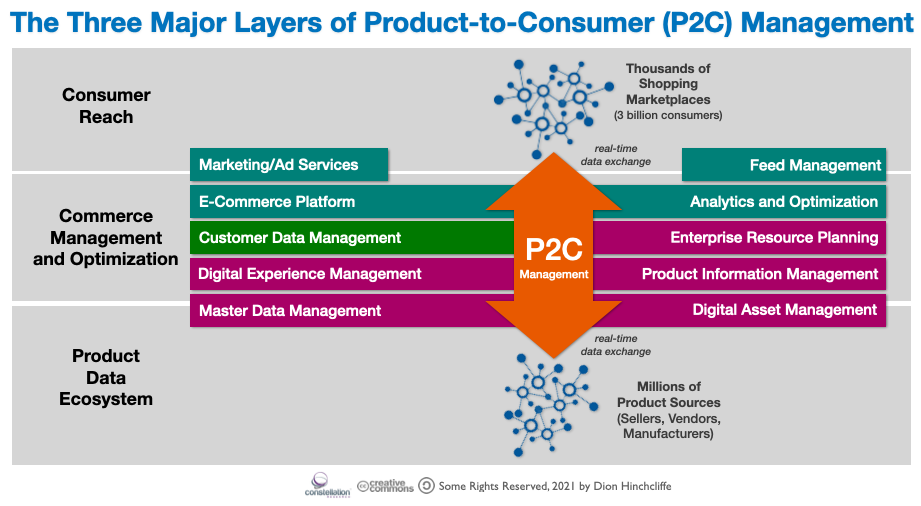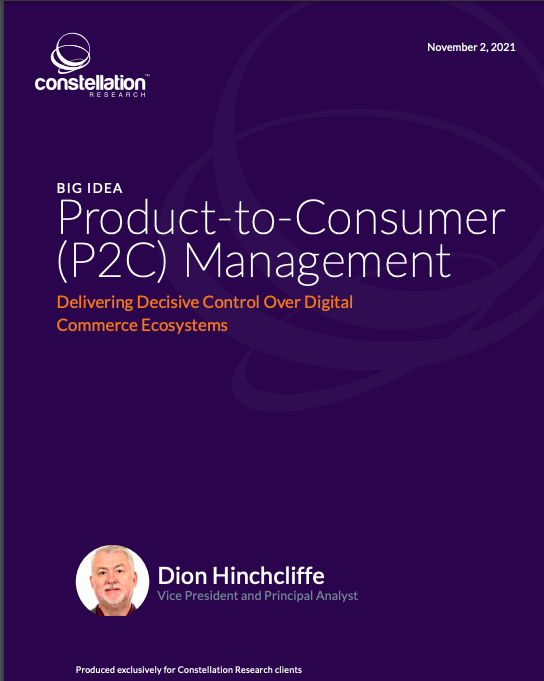The world of digital commerce has grown in leaps and bounds over the last two and a half decades, from quite modest beginnings to an astonishing $4.2 trillion in global revenue this year. In all ways that it matters, from wide product availability and deep consumer uptake to operational complexity and business sophistication, e-commerce has become a vast industry that powers much of the world of retail consumer sales today.
However, along with this maturity has become ever-growing overhead in time, resources, and management attention on making the many moving pieces -- product catalogs, commerce systems, feeds, channels, and marketplaces -- fit together and properly operational in a way that is truly sustainable as a business.
Related Research Report: P2C Management
Along the way a number of product categories have attempted to alleviate the many individual challenges of building and running an e-commerce business. Product information management (PIM) tools made product feeds/catalogs more manageable. The power of enterprise resource management (ERP) platforms were brought to bear on tracking the e-commerce supply chain. Experience management platforms were acquired to provide better buying journeys. Customer and master data (CDP, MDM) tools were used to sort out the torrents of product and customer data flying through a ever-greater number of feeds, channels, and marketplaces. Marketing and advertising services were used to maximize sales and product positioning. Workflow tools began to manage the synchronization of integrated systems.
Automation eventually moved from managing feeds and synchronization to silent governing and maximizing more strategic activities like campaign management, content enrichment, and ROI optimization. Then there was the cross-cutting concerns of running effectiviely across critical silos and boundaries such as different countries, multiple clouds, various local e-commerce platforms, multiple stores, many brands, and a multitude of currencies.
Modern Digital Commerce is About Taming Complexity
This then is the situation that digital commerce firms increasingly encountered in the 2010s: The sheer proliferation of data, channels, systems, and silos/boundaries. This includes managing the timely data flows between them, dealing with a constantly changing fabric of inbound and outbound systems, operational processes that made the most of such data, all sitting on top a large and unwieldy hub of core systems began to weigh on the growth and potential of many stories.
Out of this, a few of the firms that specialized in helping organizations operate in this high velocity and turbulent environment began to offer more integrated solutions that began to create an overarching and holistic operational construct on top of this constant swirl of commerce technology and supporting processes.
After discussing these trends with those in the industry for a while and examining the resulting solutions, it began to become clear that a genuine new product category was emerging that sat an entire level above the rest of the e-commerce solution landscape.
Understanding the Holistic Capabilities of P2C Management
In short, P2C Management provides an entirely new high level abstraction for how a digital commerce ecosystem functions. Instead of manually having to operate the functional operations of digital product marketing and sales across hundreds of product feeds and hundreds more consumer touchpoints -- or even harder, effectively optimize and maximize the commerce outcomes in al lthese combination, the category of P2C Management provides a single and consistent way to do this. As my new report explores in much greater detail, the three main strategic functions that a P2C Management platform offers is:
- Consumer reach: Real-time syndication to a very large number of consumer marketplaces with both marketing and advertising support
- Commerce management and optimization: Enabling of the cross-platform operations and continuous automated improvement of a commerce business across myriad product providers and consumers
- Product data ecosystem: Large-scale integration of product information sources such as sellers, vendors, and manufacturers
In my research, I've also uncovered ten candidate platforms that offer some subset -- and sometimes nearly all -- of these capabilities in a way that can provide a very substantial and strategic improvement to digital commerce operations and business outcomes. These solutions I've summarized in a new Constellation Research ShortList that was published separately today with the main research report that explores and describing P2C Management.
The current solutions for P2C Management that Constellation Research has identifed so far include offerings from Akeneo, ChannelAdvisor, Inriver, Pimcore, Productsup, Riversand, Salsify, Skubana, Syndigo, Webgility.
The formal high level defintion of the P2C Management category is as follows:
P2C Management solutions provide a systematic way of maximizing the total overall effectiveness of product information value chains. P2C almost completely automates the complex real-time flows of the key inputs and outputs of product information in an -commerce environment. Such solutions enable the strategic administration, management, and governance across an unlimited number of stores, catalogs, consumer touch points, product items, transactions, and buyers.
Successful P2C Management solutions optimize and maximize each element of the commerce ecosystem including content, marketing, advertising, pricing, campaigns, sales, testing, and fulfillment to maximize ROI and net profitability.
P2C is most effectively realized by a platform that is designed from the ground up to deal effectively with today’s hyperscale and deeply integrated commerce operating environments. Effective realization of P2C results in higher conversion, more revenue, larger margins, faster growth, more repeat sales, higher stock efficiency and larger customer lifetime value.
Introducing Product-to-Consumer (P2C) Management: A Strategic New Product Category for Digital Commerce from Digital Enterprise Today on Vimeo.
Developing the P2C Management Category
While few of these companies themselves yet identify themselves with this strategic new category, I am convinced it is the inevitable overarching future of digital commerce. The sheer complexity and unwieldy nature of operating today's contemporary e-commerce business through one of the aging, functionally partitioned, and siloed capabilities that it is composed of is no longer really possible. With none of the constituent parts of an integrated e-commerce operation offering a suitable home for overall management, operations, and governance, it is left to the solutions that are aimed at the whole picture, from data and systems, to products and consumers.
Thus, my research shows that the P2C Management category is becoming the new "top of the stack" of digital commerce, and will be one of the most important to watch as it evolves and matures through the 2020s. While this category is becoming necessary to become and remain an efficient and profitable e-commerce business at the higher end of the market, I do anticipate the democratization of the category as it become easier to integrate, learn, and adopt for less mature organizations. Nevertheless, the P2C Management market is already quite large, with a total addressable market of over $11 billion in 2021. I look forward to covering this space more closely as this emerging category expands and grows throughout the decade.
My Additional Research on This Topic:
The P2C Management Vendor ShortList for 2021
Realizing a Decisive Advantage in Digital Commerce Through Economic Flexibility
How Headless Revolutionized Content Management
The Future of Enterprise Content Management
A New Digital Experience Maturity Model for Improved Business Outcomes
How CXOs Can Attain Minimum Viable Digital Experience for Customers, Employees, and Partners
To Strategically Scale Digital, Enterprises Must Have a Multicloud Experience Integration Stack




